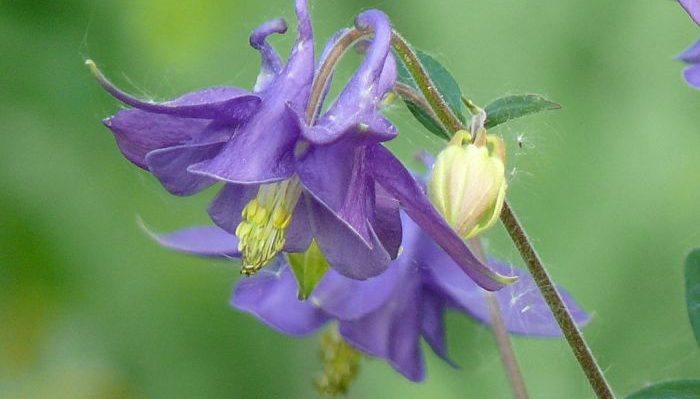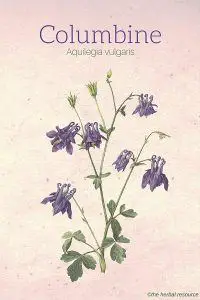Botanical Name: Aquilegia vulgaris.
The Latin name for the Genus Aquilegia is thought to have derived from the Latin word “aquila”, meaning eagle, probably because the curved nectar spurs resemble an eagle’s beak or an eagle’s claw.
The name may also come from the Latin words “aquam legere” (to collect water) that refers to the flower’s funnel-like shape where moisture is collected. The species name vulgaris means quite simply “common”.
Other Common Names: European columbine, true columbine, European crowfoot, culverwort, granny’s bonnet. Akelei (German), l’ancolie commune (French), aguileña (Spanish), skógarvatnsberi (Icelandic), akeleje (Danish), akileija (Finnish), akleja (Swedish), akeleie (Norwegian).
.
Habitat: Columbine is originally native to Central and Southern Europe, Asia and North Africa.
The plant has been cultivated both as an ornamental and a medicinal plant since medieval times. It is often found growing wild in meadows, forest edges, beach edges, ditches, parks and around old house ruins. It usually prefers dry and calcareous soils.
Columbine is a very common garden plant, and there are many cultivars of it in existence that come in a variety of flower colors. In parts of North America, it has found its way out of the gardens and become naturalized.
The plants are propagated either by seed or by a division of the roots in spring.
Plant Description: Columbine is a perennial plant that is normally 30-80 cm high. The stalk is erect, glabrous or sparsely hairy and usually branched at the top.
The plant has two to five large leaves at the base, sitting on long stalks and consisting of a terminal group of three leaflets. These leaflets are 2 to 5 cm long, green on the upper side and blue-green below. The higher the leaves grow on the stem the smaller they get.
The hanging flowers sit alone or in clusters on erect slender stalks. They are very distinctive and easily recognized in gardens or in the wild.
When found in the wild the flowers are 3-4 cm long, blue, pink or white. Cultivated varieties of columbine are however very variable in color. The flowers have a pleasant smell, not unlike that of hay, but a bitter, rather unpleasant and sharp taste.
The plant is in blossom from May to June. After flowering, a round shaped fruit appears, composed of five carpels, each containing numerous shiny dark-colored seeds. The seeds are then spread by the wind.
Plant Parts Used: The roots, leaves, flowers, and seeds have been used in folk medicine. A little known homeopathic remedy called Aqui is produced from the plant.
Health Benefits and Claims of Columbine
Active Ingredients and Substances: The plant contains several alkaloids (magnoflorine, berberine, etc.), triterpenoid saponins, flavonoids (quercetin, apigenin) and small amounts of cyanogenic glycosides (triglochinin etc.).
Traditional Uses
Columbine has been regarded as a religious symbol of purity and it is often depicted in paintings together with the Virgin Mary. In traditional herbalism the plant was considered sacred to the goddess Venus.
It is known that the plant has been used as herbal medicine since the Middle Ages and that it was used as a remedy for many ailments, such as high fever due to infectious diseases, chronic rhinitis, haemoptysis (coughing up blood or blood-stained mucus from the bronchi) and enlarged or swollen lymph nodes in neck.
The plant was also used internally as a hepatic agent to treat jaundice and gallbladder ailments.
In Spain, there is a tradition of consuming small amounts of the columbine root in the morning for several days by those who are plagued by stones in the urinary tract.
Columbine has astringent, antiseptic and wound cleansing properties and the root has been used topically in the form of a lotion to treat eczema and to accelerate the healing of wounds and cuts.
A lotion made from the leaves has been used as an herbal remedy for sore mouth and throat and a decoction made from the seeds has been used as hair shampoo to get rid of head lice and scabs.
The dried and crushed seeds were used externally to kill body parasites such as ticks.
Columbine is thought to have some immune-strengthening properties, probably due to the various glycosides found in the plant. The plant was also included in many so-called “blood-purifying” herbal mixtures.
Dosage and Administration
Today, columbine is not used much in western herbal medicine and then mostly as an astringent and diuretic. The plant is toxic and is not suitable for self-medication.
Side Effects and Possible Interactions of Columbine
Columbine is a poisonous plant. The plant contains cardiogenic toxins which can cause gastroenteritis and heart palpitations.
Ingestion of large amounts of the fresh herb (more than 20 gr) can cause convulsions, breathing problems and heart weakness. These effects are, however, short-lived. The toxins are destroyed when the herb is dried or exposed to heat.
There are no reports that the animals have been poisoned by columbine, but it is usually avoided by grazing livestock.
Supporting References
Fern, Ken: Plants for a Future. Edible & Useful Plants for a Healthier World. East Meon, Hampshire, Permanent Publications 2011.
Hensel, Wolfgang: Medicinal Plants of Britain and Europe. London, A&C Black Publishers Ltd. 2008.
Potterton, David (ed.): Culpeper’s Colour Herbal. Berkshire, Foulsham 2007.
Pullaiah, T.: Encyclopedia of World Medicinal Plants. Vol I-V. New Dehli (India), Regency Publications 2006.
Stary, Frantisek & Zdenek Berger: Poisonous Plants. Leicester, Magna Books 1995.
Vermeulen, Frans: Concordant Materia Medica. Haarlem, Emryss bv Publishers 2000.
Thordur Sturluson
Latest posts by Thordur Sturluson (see all)
- What is the Difference Between Hemp and Marijuana? - June 3, 2019


Columbine is one of many plants I look forward to seeing each spring.